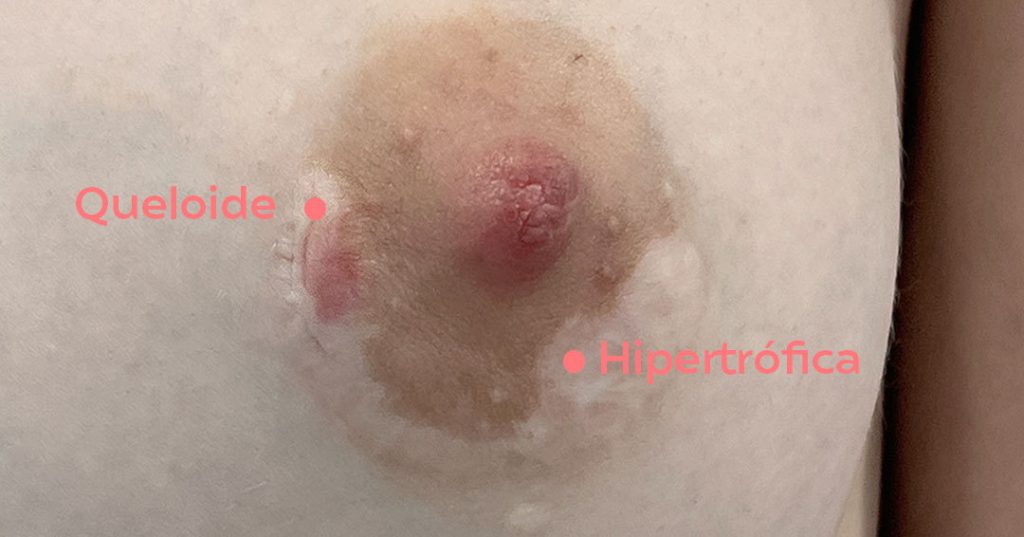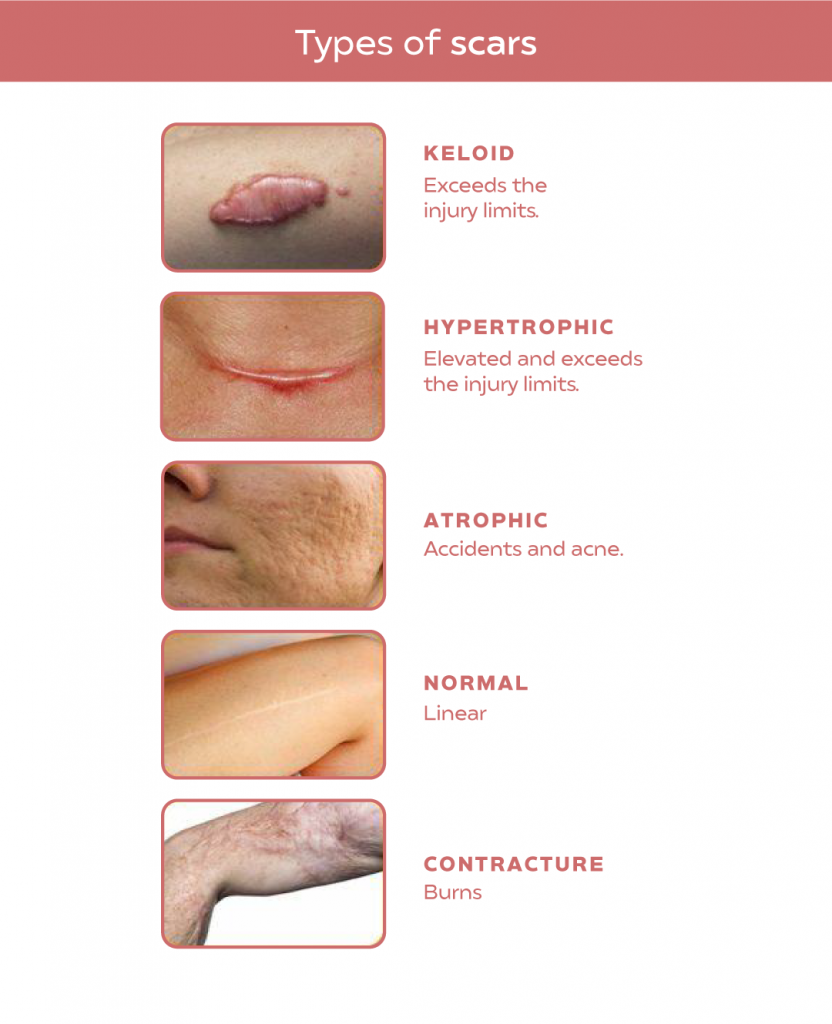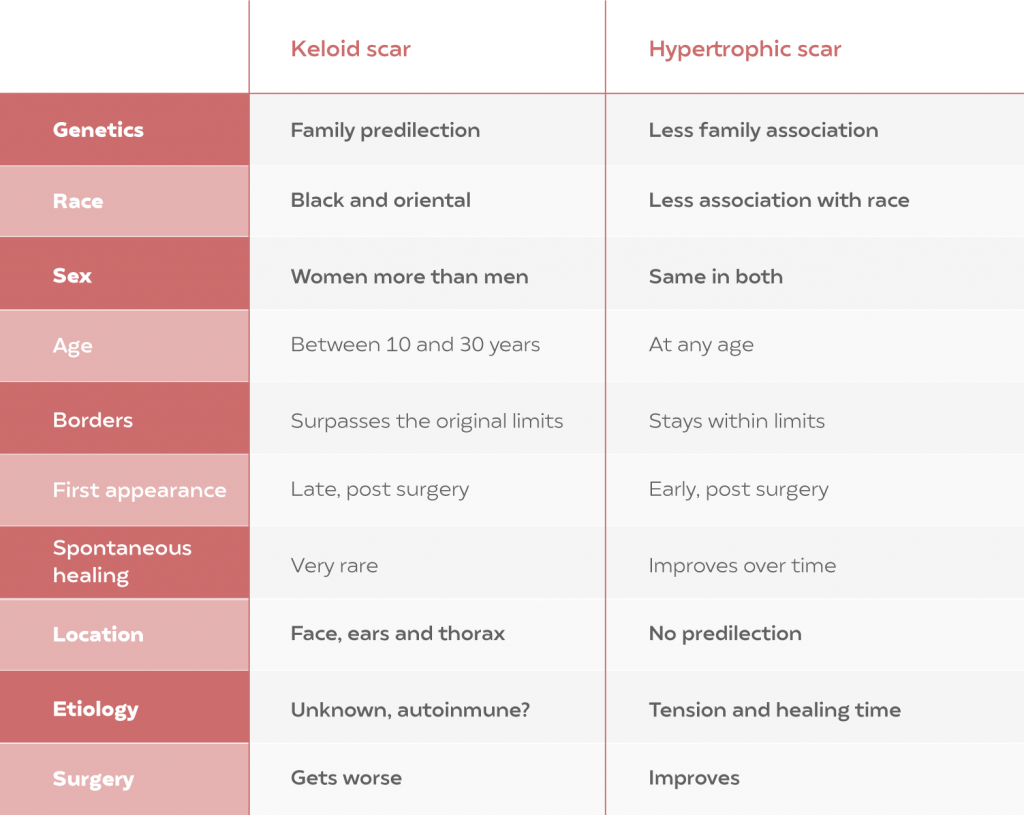
Scars are the body’s way of repairing skin damage. They are formed when collagen fibers are produced to fill in the area where the skin has been injured. Scars can be caused by a variety of factors, including inflammation, infection, and trauma.
Comparing keloids and hypertrophic scars
It is worth mentioning that while some scars are harmless and do not pose a health threat, others are abnormal and can have a negative impact on both people’s well-being and health.
Common issues with abnormal scars ⁴:
- Physical discomfort
- Itch
- Pain
- Mobility limitation
- Poor aesthetic appearance
- Psychological problems (anxiety, stress)
These problems not only impact well-being, but they also assist dermatologists in determining the most suitable treatment.

What are keloid scars?
Keloids are characterized by their thickness and the notable elevation they present above the level of the surrounding skin. Although these scars can appear anywhere on the body where there is an injury, dermatology experts point out that they are more common in areas such as the shoulders, cheeks, chest, and earlobes ².
The physical impact of keloids may seem minimal, but they can cause discomfort, such as itching and mobility problems, that can affect quality of life.
.
Major causes of keloids scars
Medicine does not yet fully understand why these scars form, but there are several factors that are likely to be involved.
From injuries and poor wound healing to genetics, race, and hormonal changes ³.
What are hypertrophic scars?
Keloids grow beyond the area of the original wound, while hypertrophic scars are confined to the area of injury. These are generally thick, rough, and reddish or pink in their early stages, although they may fade over time.
This type of scar usually begins to appear in the first weeks or months after the initial injury. Over time, their appearance may improve, although they rarely disappear completely ².
Major causes of hypertrophic scars
It is essential to differentiate between the causes of hypertrophic scars and keloids. Although some of these causes may be similar, the reality is that doctors have been able to differentiate between the two types of scars through small characteristics that make them unique. We will see these differences later.
It is important to be aware that the severity of hypertrophic scars can vary and may be the result of a combination of these causes ³.
Differences between keloids and hypertrophic scars (epidemiological and clinical)
The differences between these two types of scars are not as obvious as they may seem at first glance. They are actually significant. For dermatology professionals, recognizing these differences is crucial for determining the most appropriate treatment for each patient.
See table below:

The most significant differences between keloids and hypertrophic scars are those of genetics, race, and sex, where family history, people of African descent, and women between the ages of 10 and 30 are more likely to develop keloids.
Other factors to consider include the location, which is very common on the face, ears, and chest in keloid scars, while the etiology of this type of anomaly is unknown and surgery can worsen the scar, unlike what happens with hypertrophic scars.
Treatment with micropigmentation
Micropigmentation is a technique that allows the injection of pigments into the skin using microneedles to provide the desired coverage, with maximum precision and without pain or side effects.
In the case of scars, a custom pigment is injected to match exactly the skin tone surrounding the scar. This creates a coloring that camouflages and conceals the scar.
Red the article: Is it possible to camouflage scars with permanent make-up?
At Omicroart we are experts in the treatment of scars with micropigmentation, book your appointment with us.
References
- Andrades, P., Benítez, S., y Prado, A. (2006). Recomendaciones para el manejo de cicatrices hipertróficas y queloides. Revista chilena de cirugía, 58(2), 78-88.
- Salem, Ch., Vidal, A., Mariangel, P., y Concha M. (2002). Cicatrices hipertróficas y queloides. Revistas Electrónicas de la Universidad Austral de Chile, Cuadernos de Cirugía, Vol. 16 N° 1, 2002, pp. 77-86.
- Vistós, J., y Aliaga, M. (2010). Cicatrices hipertróficas y queloides. Revista Enfermería Dermatológica, N° 11, septiembre-diciembre 2010, pp. 15-20.
- Zaballos, P., Morales, A., Navarro, A., Salsench, E., Garrido, A., y Montañés, J. (2001). Consulta diaria. Qué haría usted ante… los queloides y las cicatrices hipertróficas. Medicina Integral, Vol. 38, Núm. 9, Noviembre 2001, pp. 385-389.





